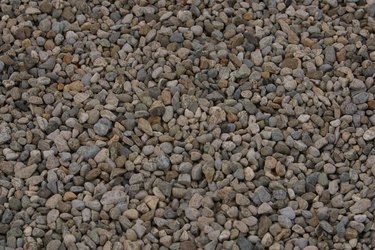
Rock is a common landscape material for driveways, paths and bedding areas. You can find a variety of stone, ranging from small gravels to boulders and even cobbles. Since these are size distinctions, you can find any type of rock that fit the description for use in your landscape. Some rocks sizes are useful inside your home and add interest to the decor.
Small Gravel
Video of the Day
Soil scientists separate gravel materials into two groups. Fine gravels range in size from 4.75 mm to 19 mm. This size is easy to see with the naked eye. The smallest gravels are slightly larger than sand grains and the largest gravels in this size range are roughly the size of a pea. Pea gravel is a common industry term for gravels in this size range. These gravels are useful in driveways and pathways as a base material for pavement or larger stones. These gravels may also be good filler material in a rock garden, around swing sets or in areas where you need to increase drainage.
Video of the Day
Large Gravel
Large, or coarse, gravels range in size from 19 mm to 64 mm. Gravels in this range are roughly the size of a lemon. As with the smaller gravels, you can find large gravel with both polished and rough surfaces. Large gravel is common in landscape beds and rock gardens. You can find many rock types in this size range for your landscape. Scoria, or lava rock, is a popular red stone, while limestone and sandstone are often a natural tan or gray color. Granite rock is often used in landscape beds due to its high durability and attractive speckled appearance. Indoors, you can use both gravel sizes in clear vases and bowl for a natural decor.
Cobble Stones
Cobbles, ranging in size from 64 mm to 256 mm, are a size larger than coarse gravel. Cobbles are the approximate size of a grapefruit so they large enough to use both inside and outside your home, but are lightweight enough to handle efficiently. You can use cobbles in a garden as a pathway stone or a main stone in a rock garden. Inside, you can use cobbles as bookends or as decoration with large potted plants. Stones such as granite, schist, gneiss and sandstone show nice color and texture in cobble-sized pieces.
Boulder Stones
Boulders are larger than cobbles at a size greater than 256 mm. These stones are typically the size of basketballs or larger. Boulders make interesting focal points in a landscape design. Because of their large size, boulder-sized stones are able to display the unique mineral content and texture of each rock. Speckled granites and monzonites are durable in a garden as is sandstones that may be uniform or layered in appearance. Boulder-sized limestone may exhibit fossils that add interest to the landscape.